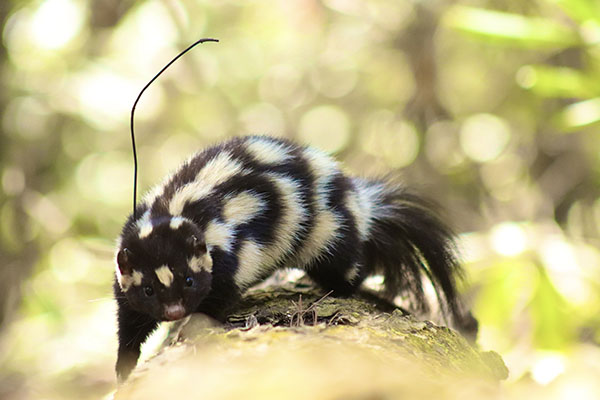 Spotted skunk with tracker, by Gregory P. Detweiler
Spotted skunk with tracker, by Gregory P. Detweiler It has been 57 years since the Eastern spotted skunk had a confirmed sighting in Maryland back in 1967. Compact and cute, these carnivorous mammals are in the family Mephitidae along with Maryland’s other skunk species, the striped skunk. The Eastern spotted skunk is a medium-sized, slender mammal with a small head, short legs, and a prominent, long-haired tail. The eyes are petite and the ears short. Its glossy fur is black with white spots and small stripes scattered throughout. A white spot occurs on the forehead and in front of each ear. The tail is usually all black, sometimes with a white tip.
Eastern spotted skunks are fairly social and considered non-territorial. Their dens are something akin to nature’s motels as different individuals may use the same den on different days. These dens which are usually above ground, consist of holes or crevices under tree stumps or log hollows. While Eastern spotted skunks spend most of their winters in dens, they aren’t considered true hibernators because they awaken sometimes on mild winter days to eat. These creatures are mainly nocturnal and resort to climbing trees or freezing in place to avoid being spotted by predators. It is theorized that their spotted black and white coloring may help them camouflage on moonlit nights. Much like any other skunk in the family Mephitidae, if they feel threatened they will spray their would be attackers. One unique behavior of spotted skunks though is that they will balance on their forefeet with their hind legs and tail up in the air, in the direction of the threat; this position enables accurate spraying of the intruder with musk.
The musk sprayed by skunks is a liquid produced by the animal’s anal glands. It contains several types of volatile chemical compounds. The primary smelly compounds are thiols and thioacetates, both rich in sulfur—giving it that “charming” repulsive odor. Sulfur atoms in thiols and thioacetates also have a lot of stability in the way they bond to other atoms, which is part of the reason the smell is hard to get rid of. The smell has been described in many different ways. A quick search around the internet shows descriptors such as that from far away it smells vaguely like coffee. As you get closer the smell resembles cannabis and when you get very close to the odor it tends to smell like rotten eggs and is so strong that you can not only smell it but also taste the odor. Hopefully that description hasn’t deterred the reader from liking these adorable creatures as they will only spray when threatened.
There is hope that Eastern spotted skunks can be found again in Maryland, since there are established populations in West Virginia and Pennsylvania. The Eastern spotted skunk’s decline in Maryland can be attributed to trapping for the fur industry in the past, and some records even suggest that these creatures might have been used as bait to trap other animals. Presently a study revealed that the largest current cause of spotted skunk mortality is predation by Great horned owls and in one case barred owls.
If a skunk comes to your yard it is usually not a cause for concern unless you have outdoor dogs. If you prefer to avoid them completely then you will need to eliminate outdoor food sources such as dog or cat food, bird feeders, exposed trash cans, and compost piles. Strong smelling repellents can be used to deter them from living under porches or crawl spaces. Ammonia soaked rags should do the trick. Skunks are also great at controlling garden pests as their diet consists of just about every pest found harming your garden. If you would prefer to have skunks as friendly garden visitors there are a few things to take into consideration to make the habitat on your property favorable for them. Skunks prefer semi-open areas, grassy and weedy fields, brushland, pastures, and rural and urban neighborhoods. Usually, they will den close to water. The striped skunk prefers an underground den that is in well drained soil. Ideal conditions for striped skunks are wooded hillsides, bordering pastures or hayfields. We encourage anyone with trail camera photos or other documentation to report any Eastern spotted skunks they think they've seen to the Maryland Department of Natural Resources.
For more information on managing skunks:
https://extension.umd.edu/resource/skunks/
For specific information about Eastern spotted skunks:
https://easternspottedskunk.weebly.com/
How to be welcoming to our skunky friends:
https://www.wildliferescueleague.org/animals/gardeners-best-friend-master-of-pest-control-the-skunk/
https://bioone.org/journals/southeastern-naturalist/volume-20/issue-sp11/058.020.0sp1111/Genetic-Confirmation-of-Predation-of-an-Adult-Female-Eastern-Spotted/10.1656/058.020.0sp1111.short#:~:text=We%20report%20the%20first%20confirmed,remains%20in%20eastern%20West%20Virginia
https://bioone.org/journals/southeastern-naturalist/volume-20/issue-sp11/058.020.0sp1106/Status-and-Distribution-of-the-Eastern-Spotted-Skunk-in-Maryland/10.1656/058.020.0sp1106.short#:~:text=It%20appears%20the%20Eastern%20Spotted%2cto%20Maryland%20in%20the%20future.
https://www.humanesociety.org/resources/what-do-about-skunks